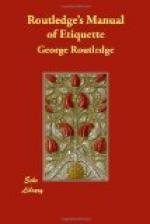BEEF.
SIRLOIN OF BEEF.
The principal joint of beef, the sirloin, must be carved outside or inside, according to the taste of the guests. The rich delicate meat under the bone, called the fillet, is carved in parallel slices across the joint and along the grain, contrary to the usual mode of cutting meat. The outer part is carved in long slices cut down to the bone in the direction 1, 2, beginning at the edge, the brown being the first slice. Many prefer to cut the slices across the joint, beginning in the middle; certainly easier for the carver, but destructive to the future appearance of the joint, nor is the meat so tender thus crossed. A portion of the under fat should be reserved for the upper slices.
[Illustration]
RIBS OF BEEF.
Must be carved like the upper part of the sirloin. There is no fillet in this joint. It is usual to begin the slices at the thin end.
ROUND OF BEEF.
With a sharp thin-bladed knife shave off in a horizontal manner the first slice, leaving the round flat and smooth. The meat is disfigured if this smoothness is not preserved; it is therefore necessary that your knife be sharp and your hand steady. It must be served in very thin slices.
[Illustration]
THE AITCH-BONE, OR EDGE-BONE
Is usually skewered and boiled with part of the rump, forming a sort of round, to be carved the same way as the round. The soft, marrow kind of fat is at the back of the bone, below 4, and must be supplied when required; the harder fat is at the edge of the meat, 3, and will accompany each slice.
RUMP OR BUTTOCK OF BEEF.
In carving the rump, buttock, or other joints of beef, it is merely necessary to observe, that every slice should be as neatly as practicable cut across the grain. Even in the brisket, the slices must be across the bones, and not through.
[Illustration]
TONGUE.
The tongue may be sent to table either rolled or in length. If rolled, slices are cut as in a round of beef; if not rolled, it must be cut nearly in the middle, not quite through, and slices taken from each side, with a little of the fat which lies at the root, if liked.
[Illustration]
VEAL.
CALF’S HEAD.
The half-head is often sent to table; but when a whole head is served, it is only necessary to know the delicate parts and to distribute them impartially. Long slices of the gelatinous skin, cut down to the bone from 1 to 2, must be served. The throat sweetbread, as it is called, lies at the thick neck end; and slices, from 3 to 4, must be added to the gelatine. The eye is also a delicacy: this must be extracted with the point of the knife, and divided at discretion. The palate, situated under the head, must also be apportioned, and, if necessary, the jaw-bone should be removed, to obtain the lean meat below it.




